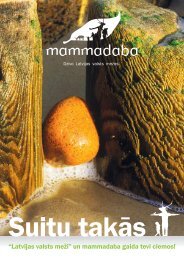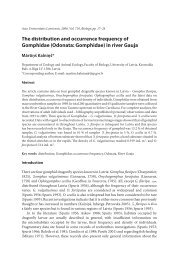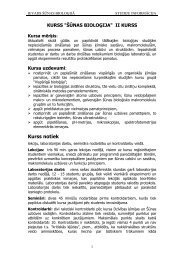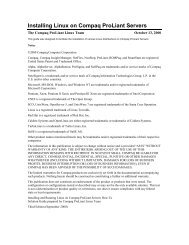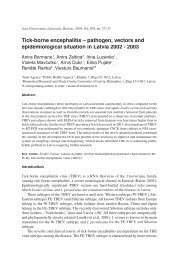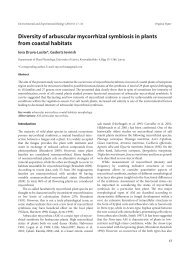Biohydrogen production in anaerobic fluidized bed reactors: Effect of ...
Biohydrogen production in anaerobic fluidized bed reactors: Effect of ...
Biohydrogen production in anaerobic fluidized bed reactors: Effect of ...
You also want an ePaper? Increase the reach of your titles
YUMPU automatically turns print PDFs into web optimized ePapers that Google loves.
<strong>in</strong>ternational journal <strong>of</strong> hydrogen energy 35 (2010) 3379–3388 3385<br />
Fig. 5 – SEM micrograph <strong>of</strong> bi<strong>of</strong>ilm attached to support materials: (a, b) polystyrene and (c, d) expanded clay (HRT [ 2h;a,c,<br />
magnification 10003; b, d, magnification 30003).<br />
In general, the proportion <strong>of</strong> EPS <strong>in</strong> bi<strong>of</strong>ilms can vary<br />
between roughly 50 and 90% <strong>of</strong> the total organic matter. The<br />
best-<strong>in</strong>vestigated component <strong>of</strong> EPS is the polysaccharide<br />
moiety. EPSs such as polysaccharides are key compounds for<br />
microbial adhesion. However, the matrix is also composed <strong>of</strong><br />
other components such as prote<strong>in</strong>s, nucleic acids and lipids<br />
[36]. Bi<strong>of</strong>ilm accumulation on a support is a dynamic process<br />
that is the net result <strong>of</strong> growth and detachment. Bi<strong>of</strong>ilm<br />
formation is affected by several external factors, <strong>in</strong>clud<strong>in</strong>g the<br />
composition and the concentration <strong>of</strong> the feed, the velocity <strong>of</strong><br />
the liquid phase (shear stress), the concentration <strong>of</strong> particles,<br />
particle-particle collisions, and particle-wall collisions [55,56].<br />
In addition, the nature and the concentrations <strong>of</strong> substrates<br />
may affect bi<strong>of</strong>ilm growth and composition [55,57].<br />
Under a high substrate load<strong>in</strong>g rate (low HRT), bi<strong>of</strong>ilm<br />
accumulation is higher, which can affect the structures<br />
formed. The amount <strong>of</strong> EPS synthesis with<strong>in</strong> the bi<strong>of</strong>ilm<br />
depends greatly on the availability <strong>of</strong> carbon substrates (both<br />
<strong>in</strong>side and outside the cell) and on the balance between<br />
carbon and other limit<strong>in</strong>g nutrients. The presence <strong>of</strong> excess<br />
available carbon and limitations <strong>in</strong> other nutrients (such as<br />
nitrogen, potassium, or phosphate) may favor EPS <strong>production</strong><br />
over cell formation and consequently the concentration <strong>of</strong><br />
active biomass [55,58].<br />
In this study, the formation <strong>of</strong> EPS was related to the HY <strong>in</strong><br />
AFBRs. Fig. 6 shows the variations <strong>in</strong> total volatile solids (TVS)<br />
content, EPS content <strong>in</strong> the form <strong>of</strong> prote<strong>in</strong>s, and EPS content<br />
<strong>in</strong> the form <strong>of</strong> carbohydrates <strong>in</strong> the biomass attached to<br />
polystyrene and expanded clay particles as a function <strong>of</strong><br />
Support)<br />
-1<br />
g<br />
(mg Carbohydrate<br />
Carbohydrate<br />
Support)<br />
-1<br />
Prote<strong>in</strong> (mg Prote<strong>in</strong> g<br />
0.40<br />
0.32<br />
0.24<br />
0.16<br />
0.08<br />
0.00<br />
0.0<br />
0 1 2 3 4 5 6 7 8 9<br />
HRT (h)<br />
Carbohydrate - R1<br />
Carbohydrate - R2<br />
Prote<strong>in</strong> - R1<br />
Prote<strong>in</strong> - R2<br />
Biomass - R1<br />
Biomass - R2<br />
Fig. 6 – <strong>Effect</strong> <strong>of</strong> HRT on the biomass attached and EPS<br />
content (carbohydrate and prote<strong>in</strong> forms) <strong>in</strong> the AFBRs<br />
conta<strong>in</strong><strong>in</strong>g polystyrene (R1) and expanded clay (R2).<br />
1.4<br />
1.2<br />
1.0<br />
0.8<br />
0.6<br />
0.4<br />
0.2<br />
Support)<br />
-1<br />
attached (mg VTS g<br />
Biomass





